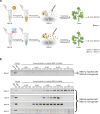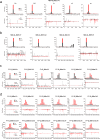Diversity and infectivity of the RNA virome among different cryptic species of an agriculturally important insect vector: whitefly Bemisia tabaci
- PMID: 33986295
- PMCID: PMC8119434
- DOI: 10.1038/s41522-021-00216-5
Diversity and infectivity of the RNA virome among different cryptic species of an agriculturally important insect vector: whitefly Bemisia tabaci
Abstract
A large number of insect-specific viruses (ISVs) have recently been discovered, mostly from hematophagous insect vectors because of their medical importance, but little attention has been paid to important plant virus vectors such as the whitefly Bemisia tabaci, which exists as a complex of cryptic species. Public SRA datasets of B. tabaci and newly generated transcriptomes of three Chinese populations are here comprehensively investigated to characterize the whitefly viromes of different cryptic species. Twenty novel ISVs were confidently identified, mostly associated with a particular cryptic species while different cryptic species harbored one or more core ISVs. Microinjection experiments showed that some ISVs might cross-infect between the two invasive whitefly cryptic species, Middle East Asia Minor 1 (MEAM1) and Mediterranean (MED), but others appeared to have a more restricted host range, reflecting the possibility of distinct long-term coevolution of these ISVs and whitefly hosts. Moreover, analysis of the profiles of virus-derived small-interfering RNAs indicated that some of the ISVs can successfully replicate in whitefly and the antiviral RNAi pathway of B. tabaci is actively involved in response to ISV infections. Our study provides a comprehensive analysis of the RNA virome, the distinct relationships and cross-cryptic species infectivity of ISVs in an agriculturally important insect vector.
Conflict of interest statement
The authors declare no competing interests.
Figures





Similar articles
-
Diversity and transmissibility of RNA viruses in the small brown planthopper, Laodelphax striatellus.J Virol. 2024 Dec 17;98(12):e0019124. doi: 10.1128/jvi.00191-24. Epub 2024 Nov 26. J Virol. 2024. PMID: 39589138 Free PMC article.
-
Molecular markers for the identification and global tracking of whitefly vector-Begomovirus complexes.Virus Res. 2000 Nov;71(1-2):233-60. doi: 10.1016/s0168-1702(00)00221-5. Virus Res. 2000. PMID: 11137175
-
Deciphering the Tissue Tropism of the RNA Viromes Harbored by Field-Collected Anopheles sinensis and Culex quinquefasciatus.Microbiol Spectr. 2022 Oct 26;10(5):e0134422. doi: 10.1128/spectrum.01344-22. Epub 2022 Aug 15. Microbiol Spectr. 2022. PMID: 35968979 Free PMC article.
-
Transmission of Begomoviruses and Other Whitefly-Borne Viruses: Dependence on the Vector Species.Phytopathology. 2020 Jan;110(1):10-17. doi: 10.1094/PHYTO-07-19-0273-FI. Epub 2019 Nov 18. Phytopathology. 2020. PMID: 31544592 Review.
-
Transmission specificities of plant viruses with the newly identified species of the Bemisia tabaci species complex.Pest Manag Sci. 2014 Oct;70(10):1547-52. doi: 10.1002/ps.3738. Epub 2014 Mar 3. Pest Manag Sci. 2014. PMID: 24464790 Review.
Cited by
-
Characterization of Two Novel Insect-Specific Viruses Discovered in the Green Leafhopper, Cicadella viridis.Insects. 2022 Apr 12;13(4):378. doi: 10.3390/insects13040378. Insects. 2022. PMID: 35447820 Free PMC article.
-
Deep mining reveals the diversity of endogenous viral elements in vertebrate genomes.Nat Microbiol. 2024 Nov;9(11):3013-3024. doi: 10.1038/s41564-024-01825-4. Epub 2024 Oct 22. Nat Microbiol. 2024. PMID: 39438719 Free PMC article.
-
Cross-kingdom RNA interference mediated by insect salivary microRNAs may suppress plant immunity.Proc Natl Acad Sci U S A. 2024 Apr 16;121(16):e2318783121. doi: 10.1073/pnas.2318783121. Epub 2024 Apr 8. Proc Natl Acad Sci U S A. 2024. PMID: 38588412 Free PMC article.
-
Diversity and evolutionary history of RNA viruses among different horseshoe crab species.J Virol. 2025 Jul 22;99(7):e0016425. doi: 10.1128/jvi.00164-25. Epub 2025 Jun 20. J Virol. 2025. PMID: 40539782 Free PMC article.
-
Annual (2023) taxonomic update of RNA-directed RNA polymerase-encoding negative-sense RNA viruses (realm Riboviria: kingdom Orthornavirae: phylum Negarnaviricota).J Gen Virol. 2023 Aug;104(8):001864. doi: 10.1099/jgv.0.001864. J Gen Virol. 2023. PMID: 37622664 Free PMC article.
References
Publication types
MeSH terms
Substances
LinkOut - more resources
Full Text Sources
Other Literature Sources

